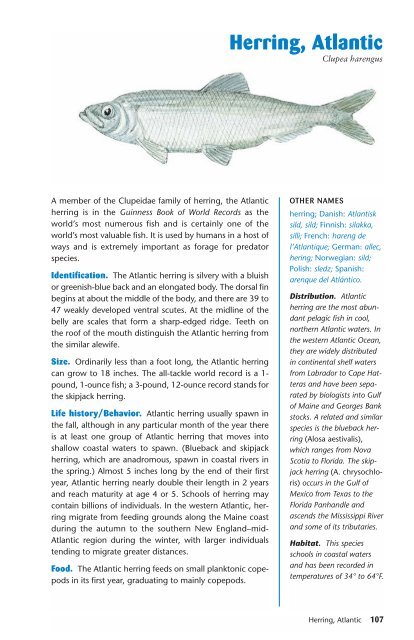Ken Schultz's Field Guide to Saltwater Fish - Macaw Pets store
Ken Schultz's Field Guide to Saltwater Fish - Macaw Pets store
Ken Schultz's Field Guide to Saltwater Fish - Macaw Pets store
You also want an ePaper? Increase the reach of your titles
YUMPU automatically turns print PDFs into web optimized ePapers that Google loves.
A member of the Clupeidae family of herring, the Atlantic<br />
herring is in the Guinness Book of World Records as the<br />
world’s most numerous fish and is certainly one of the<br />
world’s most valuable fish. It is used by humans in a host of<br />
ways and is extremely important as forage for preda<strong>to</strong>r<br />
species.<br />
Identification. The Atlantic herring is silvery with a bluish<br />
or greenish-blue back and an elongated body. The dorsal fin<br />
begins at about the middle of the body, and there are 39 <strong>to</strong><br />
47 weakly developed ventral scutes. At the midline of the<br />
belly are scales that form a sharp-edged ridge. Teeth on<br />
the roof of the mouth distinguish the Atlantic herring from<br />
the similar alewife.<br />
Size. Ordinarily less than a foot long, the Atlantic herring<br />
can grow <strong>to</strong> 18 inches. The all-tackle world record is a 1pound,<br />
1-ounce fish; a 3-pound, 12-ounce record stands for<br />
the skipjack herring.<br />
Life his<strong>to</strong>ry/Behavior. Atlantic herring usually spawn in<br />
the fall, although in any particular month of the year there<br />
is at least one group of Atlantic herring that moves in<strong>to</strong><br />
shallow coastal waters <strong>to</strong> spawn. (Blueback and skipjack<br />
herring, which are anadromous, spawn in coastal rivers in<br />
the spring.) Almost 5 inches long by the end of their first<br />
year, Atlantic herring nearly double their length in 2 years<br />
and reach maturity at age 4 or 5. Schools of herring may<br />
contain billions of individuals. In the western Atlantic, herring<br />
migrate from feeding grounds along the Maine coast<br />
during the autumn <strong>to</strong> the southern New England–mid-<br />
Atlantic region during the winter, with larger individuals<br />
tending <strong>to</strong> migrate greater distances.<br />
Food. The Atlantic herring feeds on small plank<strong>to</strong>nic copepods<br />
in its first year, graduating <strong>to</strong> mainly copepods.<br />
Herring, Atlantic<br />
Clupea harengus<br />
OTHER NAMES<br />
herring; Danish: Atlantisk<br />
sild, sild; Finnish: silakka,<br />
silli; French: hareng de<br />
l’Atlantique; German: allec,<br />
hering; Norwegian: sild;<br />
Polish: sledz; Spanish:<br />
arenque del Atlántico.<br />
Distribution. Atlantic<br />
herring are the most abundant<br />
pelagic fish in cool,<br />
northern Atlantic waters. In<br />
the western Atlantic Ocean,<br />
they are widely distributed<br />
in continental shelf waters<br />
from Labrador <strong>to</strong> Cape Hatteras<br />
and have been separated<br />
by biologists in<strong>to</strong> Gulf<br />
of Maine and Georges Bank<br />
s<strong>to</strong>cks. A related and similar<br />
species is the blueback herring<br />
(Alosa aestivalis),<br />
which ranges from Nova<br />
Scotia <strong>to</strong> Florida. The skipjack<br />
herring (A. chrysochloris)<br />
occurs in the Gulf of<br />
Mexico from Texas <strong>to</strong> the<br />
Florida Panhandle and<br />
ascends the Mississippi River<br />
and some of its tributaries.<br />
Habitat. This species<br />
schools in coastal waters<br />
and has been recorded in<br />
temperatures of 34° <strong>to</strong> 64°F.<br />
Herring, Atlantic 107


